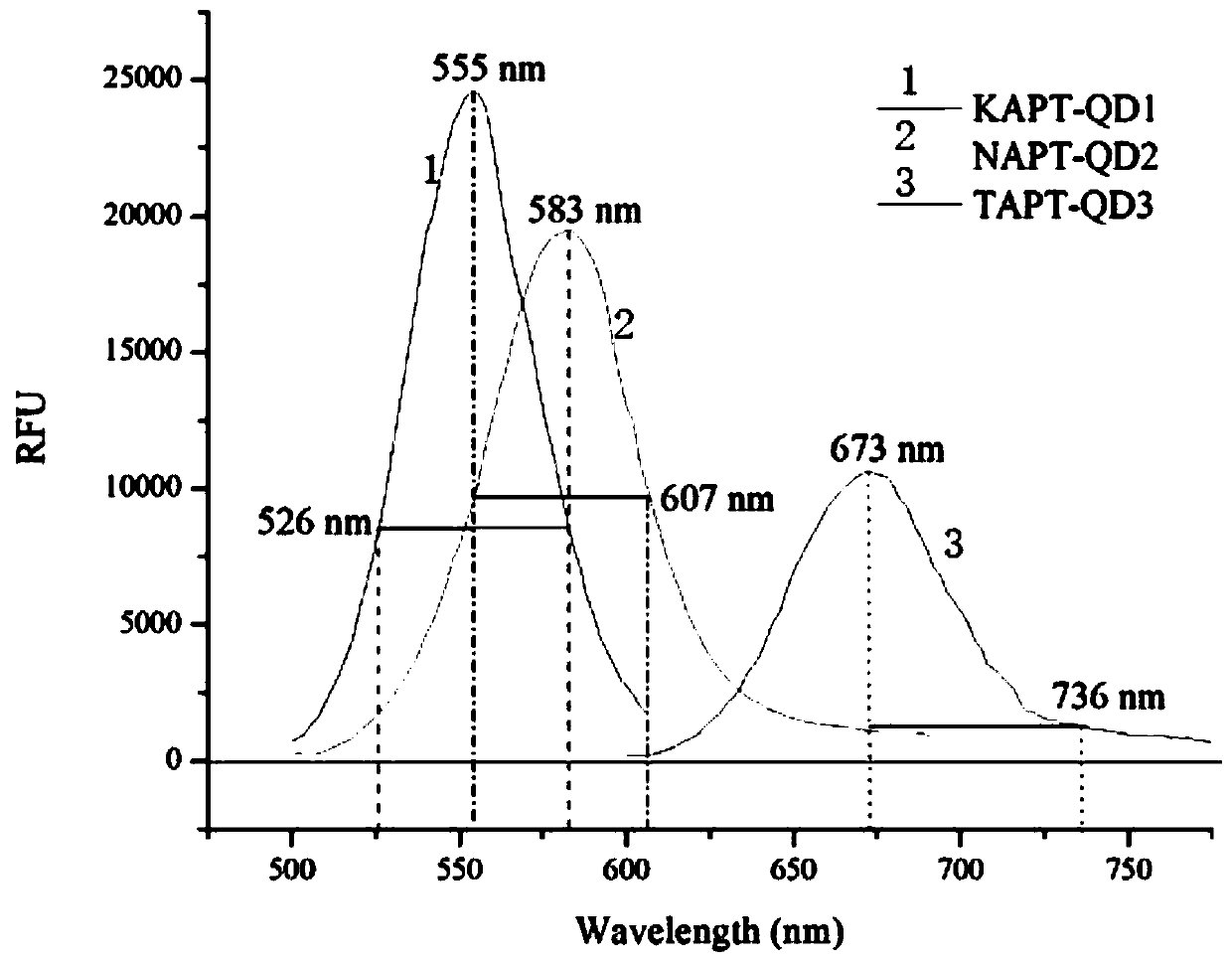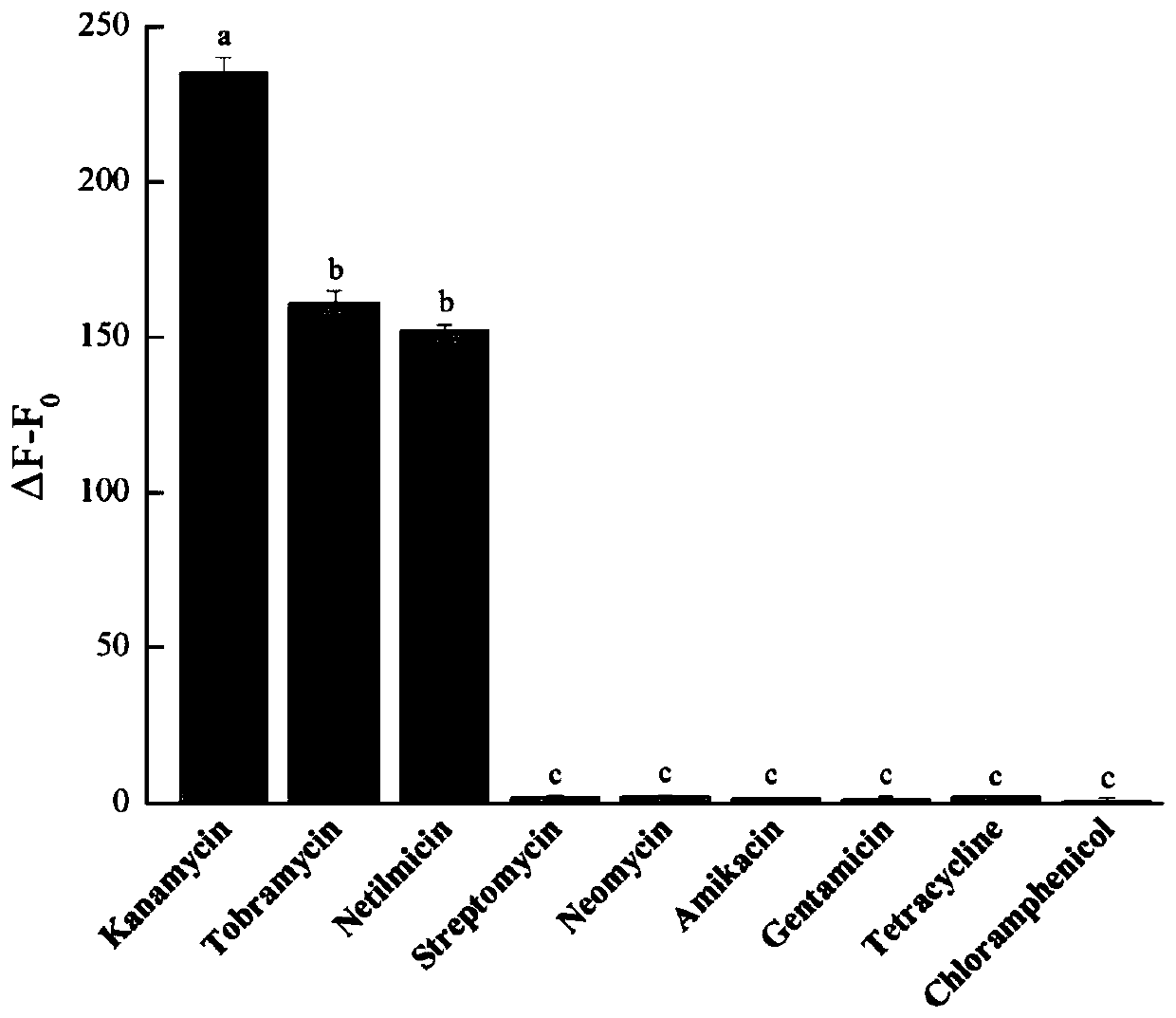Reagent of multi-residue simultaneous rapid fluorescence detection of aminoglycoside antibiotics and application thereof
An aminoglycoside and fluorescence detection technology, which is applied in the field of nanomaterial preparation, can solve the problems of high cost, stability easily affected by temperature, and difficulty in detection with large batches of samples
- Summary
- Abstract
- Description
- Claims
- Application Information
AI Technical Summary
Problems solved by technology
Method used
Image
Examples
Embodiment 1
[0033] Measure 5 μL each of QD1, QD2 and QD3 with concentrations of 21.11, 13.09 and 6.01 μmol / L, and add 1-(3-dimethylaminopropyl)-3-ethylcarbodiimide at a concentration of 10 g / L respectively 10 μL hydrochloride, dilute to 40 μL with deionized water, and react QD1, QD2 and QD3 with 1-(3-dimethylaminopropyl)-3-ethylcarbodiimide hydrochloride under ultrasonic vibration 4, 10 and 15 min. Then add KAPT, NAPT and TAPT which have been denatured at 95°C according to the ratio of KAPT:QD1 molar ratio 1:4, NAPT:QD2 molar ratio 1:5 and TAPT:QD3 molar ratio 1:5, and use phosphoric acid with pH 7.4 The volume of salt buffer solution was adjusted to 400 μL, and KAPT, NAPT, and TAPT were respectively reacted with activated QD1, QD2, and QD3 in the dark for 2 h. After the reaction, the solutions were filtered with 50kD ultrafiltration tubes, and the remaining solutions in the tubes were adjusted to 100 μL with phosphate buffer solution. In the KAPT-QD1, NAPT-QD2 and TAPT-QD3 conjugate sol...
Embodiment 2
[0036] Measure 10mL blank milk, add kanamycin, netilmicin and tobramycin mixed standard solution, then add 2mL 15% trichloroacetic acid solution, then ultrasonically shake the sample for 20min, centrifuge at 12000r / min for 10min, collect The supernatant was adjusted to 5 mL with deionized water, and the concentrations of kanamycin, netilmicin and tobramycin in it were 1, 1 and 10 μg / L, respectively. The concentrations of kanamycin, netilmicin and tobramycin were 1, 1, 10, 5, 5, 50, 10, 10, 100, 15, 15, 200, 20, 20, 500 μg / L 1 μL of the mixed standard solution series and the spiked milk sample were respectively drawn into 100 μL of the fluorescence detection reagent of the present invention, and reacted for 35 minutes. With 370nm as the excitation wavelength, measure the fluorescence intensity F at 555 and 607nm, 583 and 526nm, and 673 and 736nm for each solution after the reaction. 555nm and F 607nm , F 583nm and F 526nm and F 673nm and F 736nm . ΔF of each mixed standa...
Embodiment 3
[0038] Measure 10mL blank milk, add kanamycin, netilmicin and tobramycin mixed standard solution, then add 2mL 15% trichloroacetic acid solution, then ultrasonically shake the sample for 20min, centrifuge at 12000r / min for 10min, collect The supernatant was adjusted to 5 mL with deionized water, and the concentrations of kanamycin, netilmicin and tobramycin in it were 10, 10 and 100 μg / L, respectively. The concentrations of kanamycin, netilmicin and tobramycin were 1, 1, 10, 5, 5, 50, 10, 10, 100, 15, 15, 200, 20, 20, 500 μg / L 1 μL of the mixed standard solution series and the spiked milk sample were respectively drawn into 100 μL of the fluorescence detection reagent of the present invention, and reacted for 35 minutes. With 370nm as the excitation wavelength, measure the fluorescence intensity F at 555 and 607nm, 583 and 526nm, and 673 and 736nm for each solution after the reaction. 555nm and F 607nm , F 583nm and F526nm and F 673nm and F 736nm . Take the ΔF of each mi...
PUM
| Property | Measurement | Unit |
|---|---|---|
| Excitation wavelength | aaaaa | aaaaa |
Abstract
Description
Claims
Application Information
 Login to View More
Login to View More - R&D
- Intellectual Property
- Life Sciences
- Materials
- Tech Scout
- Unparalleled Data Quality
- Higher Quality Content
- 60% Fewer Hallucinations
Browse by: Latest US Patents, China's latest patents, Technical Efficacy Thesaurus, Application Domain, Technology Topic, Popular Technical Reports.
© 2025 PatSnap. All rights reserved.Legal|Privacy policy|Modern Slavery Act Transparency Statement|Sitemap|About US| Contact US: help@patsnap.com


